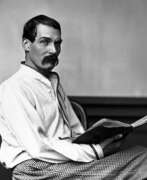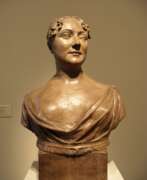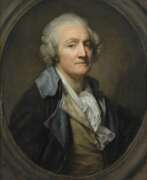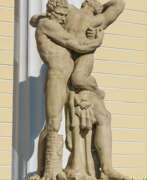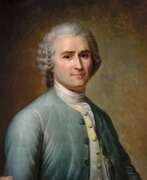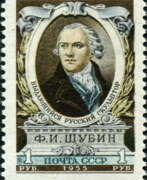Sentimentalism
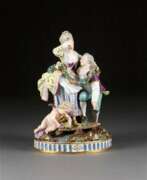

Michel Victor Acier was a French porcelain sculptor and model-maker who worked at the famous Saxon porcelain manufactory in Meissen from 1765 to 1779. With his work in the activities of the manufactory is associated with the period of neoclassicism. Michel-Victor was the maternal great-grandfather of the composer Pyotr Ilyich Tchaikovsky.
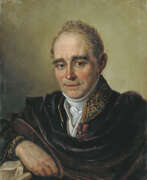

Vladimir Lukich Borovikovsky (Russian: Влади́мир Луки́ч Боровико́вский), a distinguished Russian artist of Ukrainian Cossack origin, was renowned for his mastery in portrait painting and ecclesiastical art. Born in Mirgorod, now Myrhorod, Ukraine, in 1757, Borovikovsky lived in Ukraine until the age of 31 before moving to St. Petersburg. His journey into the art world began under unusual circumstances when Empress Catherine II was impressed by his allegorical paintings, leading him to relocate to Saint Petersburg and adopt the more aristocratic surname Borovikovsky.
Borovikovsky's work epitomizes the sentimentalism era, capturing the essence and inner beauty of his subjects with a unique sensitivity and elegance. His ability to convey the nuanced emotions and dignified personalities of his sitters through intimate and detailed portraiture earned him acclaim, particularly among the Russian imperial family and nobility. Throughout his career, he produced about 500 portraits, with 400 surviving today, including notable figures such as Catherine II, Paul I, and Alexander Kurakin, as well as the celebrated "Portrait of M.I. Lopukhina".
In his later years, Borovikovsky's focus shifted towards religious painting, contributing significantly to the Kazan Cathedral and other ecclesiastical sites in St. Petersburg. Despite facing challenges, including court intrigues and a personal struggle with mental discord and alcohol, he left a lasting legacy through his art, which remains highly regarded for its depth, sincerity, and technical skill.
Collectors and experts in art and antiques cherish Borovikovsky's work for its historical significance and profound emotional resonance. His paintings, a fusion of classicist and sentimental styles, continue to inspire and captivate audiences, preserving the legacy of one of Russia's most gifted portraitists.
For updates on exhibitions and auction events featuring Vladimir Lukich Borovikovsky's work, sign up for our newsletter. Stay informed about the latest discoveries and opportunities to add a piece of history to your collection.
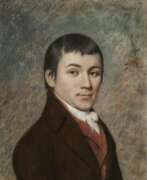

Charles Brockden Brown was an American writer, historian, and editor.
Brown took up literary endeavors early in life. In 1798, his first mystical and psychological novel, Wieland, was published. Brown also wrote the novels Ormond (1799), Edgar Huntley (1799), and Arthur Merwin (1799-1800).
Brown's works interweave fiction, history, fantasy, psychology, and liberal politics. Brown is considered the father of the American novel. His American-style Gothic novels pioneered and paved the way for two of the greatest early American writers, Edgar Allan Poe and Nathaniel Hawthorne.
Charles Brown also wrote a great deal of journalism on political, educational, and historical topics.
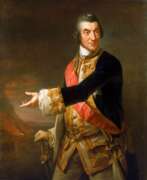

Richard Brompton was an esteemed English portrait painter, active during the mid to late 18th century. Born around 1734, Brompton honed his artistic skills under the mentorship of Benjamin Wilson and later, in Italy, with Raphael Mengs. His Italian sojourn also brought him under the patronage of the Earl of Northampton, leading to significant exposure and subsequent recognition back in England.
Brompton's mastery in portraiture gained him high-profile commissions and admittance to elite art circles, including the Presidency of the Society of Artists from 1779 to 1780. Some of his notable works include portraits of influential figures such as William Pitt, the 1st Earl of Chatham, and Admiral Sir Charles Saunders, which are preserved in prestigious locations like the National Maritime Museum and the National Portrait Gallery.
Later in his career, financial difficulties led him to St. Petersburg, Russia, where he served as the court painter to the Empress of Russia, enjoying considerable success before his death in 1783.
For those interested in the works and legacy of Richard Brompton, especially collectors and art experts, staying informed about upcoming auctions and exhibitions can be highly rewarding. To receive updates specifically about new product sales and auction events related to Richard Brompton, consider signing up. This subscription ensures you are well-informed of opportunities to acquire pieces linked to this distinguished artist.
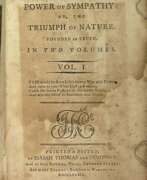

William Hill Brown was an 18th-century American novelist writer.
Brown apparently believed that one of the main purposes of literature was to instill some moral values. It is on this conviction that his novel The Power of Sympathy, or The Triumph of Truth-Based Nature (1789), which is considered the first American novel, is built. It caused a great scandal, however, because it is based on a real-life gruesome story of kidnapping, accidental incest, and suicide.
This novel is a prime example of the American approach to the European genre of the epistolary novel, but with lush descriptions of landscapes and a frank discussion of American slavery. This book can also be considered one of the first explicitly American works of literary criticism, containing lengthy reflections on the nature and purpose of literature and its role in moral formation, especially for women. The popularity of this work initiated the creation of many sentimental novels in the United States.
During his short life, Brown also wrote the romantic novel Harriot, or Domestic Reconciliation (1789), the play West Point Preserved (1797), a tragedy about the death of a Revolutionary spy, a series of verse fables, the West Indies-style comedy Penelope, and a second short novel about incest and seduction, Ira and Isabella.
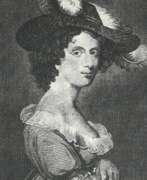

Hannah Webster Foster, born Hannah Webster, was an American writer.
Hannah received a good academic education for women and began writing political articles for Boston newspapers in the 1770s. In 1797, a sentimental novel she wrote, The Coquette, or the Story of Eliza Wharton, was published anonymously. The novel was based on a true story involving seduction, elopement, and a tragic death, and was a great success. The book was reprinted dozens of times, but it wasn't until the 1866 edition, many years after Foster's death, that the author's real name was placed on the title page for the first time.
Hannah Foster's second book, The Boarding School, or Lessons of a Female Educator to her Female Educators (1798), was devoted to the subject of education.
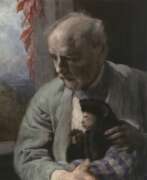

Gabriel Cornelius Ritter von Max was a Prague-born Austrian painter.
Gabriel von Max was a significant artist to emerge from the Piloty School, because he abandoned the themes of the Grunderzeitliche (genre and history), in order to develop an allegorical-mystical pictorial language, which became typical of Secessionist Art.
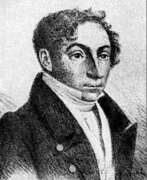

Józef Oleszkiewicz, a Polish-Lithuanian painter, was renowned for his contributions across Belarusian and Russian art scenes. Born in the late 18th century, Oleszkiewicz was celebrated for his masterful portraits and historical scenes, which were imbued with a distinctive blend of cultural influences that reflected his diverse heritage.
Oleszkiewicz's work is characterized by its meticulous detail and vibrant color palette, which set him apart from his contemporaries. His ability to capture the emotional depth and personality of his subjects made his portraits particularly revered. Among his notable works is the portrait of Adam Mickiewicz, a legendary figure in Polish literature, which is housed in the National Museum in Warsaw.
His career spanned various regions, leaving a significant mark on the art communities in Belarus and Russia as well. His influence is evident in the way he seamlessly integrated the artistic traditions of these cultures, making his works highly valuable not only for their aesthetic appeal but also for their cultural significance.
For collectors and experts in art and antiques, the work of Józef Oleszkiewicz offers a unique glimpse into the historical and cultural tapestry of Eastern Europe. His paintings are not just artistic expressions but are also historical documents that provide insight into the era's societal values and aesthetics.
To stay updated on exhibitions and auction events featuring works by Józef Oleszkiewicz, sign up for our newsletter. Ensure you never miss an opportunity to view or own a piece of this illustrious artist's legacy.
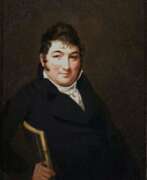

Samuel Relf was an American journalist and author.
Relf became known as the author of the novel Infidelity, or Victims of Sentimentality, first published in 1797 in Philadelphia. This scandalous book has been called "the first independent Philadelphia novel" to deal with the consequences of adultery. As a journalist, Relph built his work on stories from newspaper articles and in general, it was initially conceived as a magazine article. The book caused considerable controversy in post-revolutionary America.


Jean-Louis Voille was a French Rococo painter, renowned for his refined and delicate portraits, primarily painted during his time in Russia. Born in 1744 in Paris, Voille honed his artistic skills under the mentorship of François-Hubert Drouais at the Académie Royale. His journey as an artist took a pivotal turn when he moved to Saint Petersburg, where he became the court painter to Grand Duke Pavel Petrovich, the future Emperor Paul I of Russia.
Voille's art is celebrated for its serene and graceful portrayal of his subjects, capturing the elegance without the intrusion of strong emotions, which makes his works stand out with a distinctive calm and clarity. Among his notable works, several are housed in prestigious museums like the Hermitage in St. Petersburg, Russia. These include portraits such as "Woman in Blue" and his depiction of Ekaterina Stroganova as a child, which are considered key highlights of his career.
For those interested in the subtle beauty of Rococo art and Jean-Louis Voille's contribution to this era, staying informed about exhibitions and auction events can provide unique insights and opportunities to appreciate his work more deeply. To receive updates related to Jean-Louis Voille, including new product sales and auction events, sign up. This subscription is designed specifically for collectors and experts in art and antiques, focusing solely on relevant and curated content.
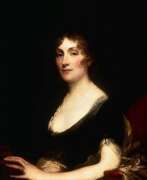

Sarah Wentworth Apthorp Morton was an American poet of the American Revolutionary period.
Sarah received a good education and early began writing poetry, the first of which was published under the pseudonyms Constance or Philenia. Frequent publications in periodicals made Filenia a prominent American poetess of her period, critics even in Europe paid attention to her.
Sarah Morton was called "American Sappho" by her contemporaries and was considered one of the finest women poets of the 18th century. She wrote long, sentimental, narrative poems that discuss the composition of the new nation, interracial relations, and heroism, both male and female. She also wrote about the virtues of freedom.
